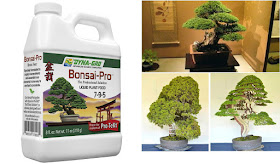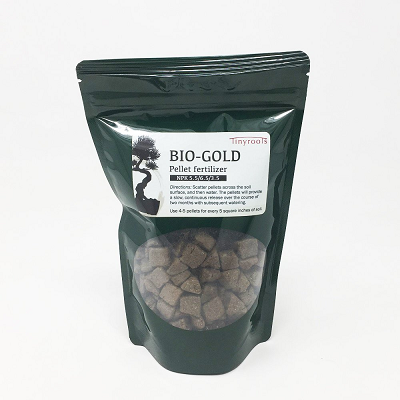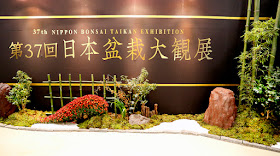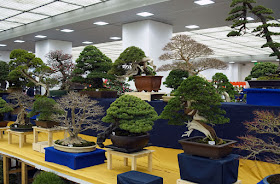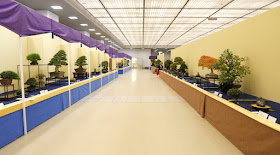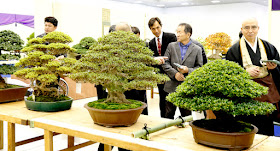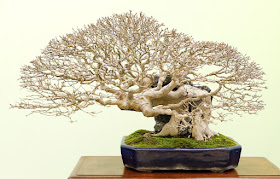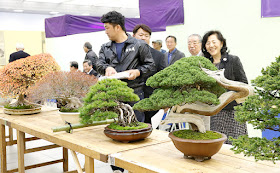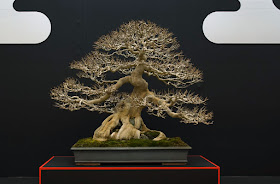Bonsai Fertilizer Explained
The best fertilizer is a bonsai fertilizer specifically formulated to provide an optimum level of salt in the soil solution when used as directed. In other words, Fertilizer is simply an alternate source of all the basic nutrients, such as nitrogen, phosphorous, potassium, and trace minerals that exist naturally in a healthy soil. Fertilizer feeds the soil, not the bonsai. Fertilizer breaks down in the soil, either by being dissolved in water or by microbial action, releasing its nutrients in a form that plant roots can absorb. Plants use nitrogen for leaf production, phosphorus for root and flower production, and potassium for flower production and general vigor. General purpose fertilizers are typically balanced. They contain all three major nutrients which are present in the proportions likely to be found in a healthy soil. These general purpose fertilizers are suitable for use on lawns, trees, shrubs, flowers, even vegetable gardens where there are no special problems with the soil.
Special purpose fertilizers are typically "unbalanced" featuring a greater proportion of one or the other major nutrients or special trace minerals or enzymes that suit them for particular situations or bonsai. For instance, there are bonsai fertilizers labeled for acid-loving plants such as azaleas that help provide iron in a form that these plants can use. Let the directions on the fertilizer be your guide and, when possible, use a specialized bonsai fertilizer to maintain its health.
Fertilizing regularly during the growth season is crucial for your Bonsai to survive. Normal trees are able to extend their root system looking for nutrients; Bonsai however are planted in rather small pots and need to be fertilized in order to replenish the soil's nutritional content. I've found a very interesting video from an experienced Filipino Bonsai enthusiast that explains fertilizing methods.
What is NPK on fertilizer labels?
Don't be intimidated by the three-number code on bags of fertilizer. It indicates the levels of nitrogen (N), phosphorus (P), and potassium (K) in the fertilizer. Nitrogen is responsible for the intensity of the color green in the plant. Phosphorous is good for maintaining the root system as well as the plant's blooming and fruiting. Potassium is necessary for the general vitality of the plant. You can read our article for more information about NPK.
What's the difference between liquid fertilizers and granular pellets?
Fertilizer is available in two types: liquid and granular. Choose the one that meets your needs in the form that is easiest for you to use. Liquid fertilizers are fast-acting and quickly absorbed. However, liquid fertilizers require more applications. Every time you water your bonsai, you washing away the fertilizer you previously applied. Granular fertilizers are applied dry and must be watered in. Granular fertilizers are easier to control because you can actually see how much fertilizer you are using and where it is being dispersed. Both fertilizer types are appropriate for bonsai gardeners, and most bonsai gardeners will use both types of fertilizer for maximum balance.
Is there an advantage to using organic fertilizer?
The major elements needed for your bonsai are N, P, and K. The source doesn't matter to the plant. The salts will ultimately be employed by the bonsai in exactly the same fashion. The major benefit of organic fertilizer is that it releases nitrogen slowly and it is less likely to burn the roots of the bonsai if you accidentally over-fertilize. Some fertilizers, such as chicken manure or liquid fish meat, have a distinct odor, so you may not want to use them on indoor bonsai. However, not all organic fertilizers will smell bad.
Also, organic fertilizers do not always contain all of the trace elements and minerals your bonsai needs. Therefore, you may need to apply several different organic fertilizers or apply them more frequently to compensate. It may be a good idea to alternate fertilizers (organic and non-organic) from time to time in order to give your bonsai a mixture of trace elements.
No matter which fertilizer you choose, the most important thing is to follow the directions on the package. Using too much fertilizer or using it too frequently increases the risk of damage to your bonsai.
Are there times when I should avoid fertilizing my bonsai?
Yes. Probably the most important rule about fertilizing is to never feed a tree that is under stress. You should never feed a newly re-potted tree, a dry tree, or a tree during dormancy. After re-potting, leave the bonsai alone for at least a month before starting feeding again.
Please see the product review below, you can click on images for more details about the specific product.
Please see the product review below, you can click on images for more details about the specific product.
Liquid and Non-Liquid Bonsai Fertilizers
- Brand: Dyna-Gro
- Rated: 4.5 stars on Amazon (Customers reviews here)
- Type: liquid form
- Price: below $10
- Indoor plants: mix 1/4 to 1/2 teaspoon per gallon of water with every watering
- Outdoor plants: mix 1/2 teaspoon per gallon of water with every watering
- Monthly feeding: mix 1 teaspoon per gallon
- Hydroponic: 2-3 teaspoons per gallon of water for re-circulation type systems
- 1 teaspoon per gallon for non-recirculating
- Made in the U.S.A.
- Brand: New England Bonsai Gardens
- Rated: 4.5 stars on Amazon (Customers reviews here)
- Type: liquid form
- Price: $10 - $15
- This premium bonsai fertilizer one of the best in the market according to reviews and is essential to keeping your bonsai trees healthy and strong.
- Exclusive to New England Bonsai Gardens, a low dose 3-3-3 can be used for bonsai almost year round.
- This water soluble bonsai fertilizer is odor free and especially recommended by bonsai professionals for indoor bonsai trees.
- Contains Nitrogen for healthy foliage, Potassium for healthy root growth, and Phosphorous for bright and colorful flowers and fruits.
- 1/8 ounce bottle should last about a year for a small bonsai (up to an eight (8) inch pot). Direct from New England Bonsai Gardens.
- Made in the U.S.A.
- Brand: Superfly Bonsai
- Rated: 4.0 stars on Amazon (Customers reviews here)
- Type: Non-liquid form
- Price: $10 - $15
- Slow Release - Special blend fertilizes immediately and throughout a 1-2 month period.
- NPK optimized for Bonsai - Nitrogen (N) – for the growth of leaves on the plant. Phosphorus (P) for root growth, flower and fruit development. Potassium (K) for overall plant health.
- According to instruction it's safe and easy to use - 1/4 Pellets can be picked up by hand or with a spoon
- Rich in premium organic & natural ingredients
- Easy Zip and resealable bag
- Made in the U.S.A.
- Brand: Tinyroots
- Rated: 5.0 stars on Amazon (Customers reviews here)
- Type: Non-liquid form
- Price: $10 - $15
- Most popular time release organic bonsai fertilizer. Always fresh stock from Japan.
- Biogold is specially formulated for Bonsai, but will also work well with a wide range of plants.
- Fermented - no bad smells. Does not attract insects, no mold growth.
- Contains the three essential elements (Nitrogen, Phosphorus and Potash) and micro-nutrients to produce a balanced fertilizer.
- Triangular pellets - Will not roll off and out of your pot.
- Imported fertilizer from Japan
- Brand: Tinyroots
- Rated: 4.5 stars on Amazon (Customers reviews here)
- Type: Non-liquid form
- Price: $15 - $20
- This soil provides the plant support, moisture & drainage Bonsai trees need.
- The soil component is a mix of 100% organic double-sifted compost mulch, calcined clay, vermiculite and Frit. It contains over 28 vital trace elements and minerals that are essential for the health of your Bonsai.
- Perfectly blended for Ficus, Chinese Elms, Jades, Junipers, and other Bonsai species - two quarts of all-purpose blend Bonsai soil mix. 100% Organic and All-Natural Bonsai soil.
- Specially formulated as an all-purpose potting medium for virtually any Bonsai tree.
- Made in the U.S.A.
- Brand: BonsaiOutlet
- Rated: 4.5 stars on Amazon (Customers reviews here)
- Type: Liquid form
- Price: $15 - $20
- Nitrogen-free fertilizer for Bonsai. Use this 0:10:10 fertilizer during the winter months and for newly transplanted Bonsai trees.
- Formulated without nitrogen so it doesn't promote foliage growth, this formulation still provides a balanced delivery of phosphorus and potassium to keep your Bonsai tree's root system healthy and happy.
- Made with natural-based fish. Rich in phosphorus and potassium, this unique formula stimulates budding and flowering, as well as vigorous root growth. Use this product on all types of flowering plants for abundant colorful blooms.
- Spring feeding pines with 0-10-10 will help reduce needle length and candle extension, and encourages sturdy shoots. Fall feeding all trees with 0-10-10 will help to prevent nonseasonal soft growth that will not withstand winter, and will increase cold hardiness of the roots.
- 8oz bottle contains enough to make 16 gallons.
- Made in the U.S.A.
- Brand: Eve's Garden Special Blend
- Rated: It's a new product
- Type: Non liquid form
- Price: Below $10.00
- Slow Release 16-9-12 Granular Bonsai Fertilizer
- Time released Fertilizer, apply every 5-8 months on the surface of soil
- Last for months of the year, essential to keep your tree healthy and strong
- Safe for any house plants according to Eve's Garden
- Sold Only by Eve's Garden in 5 oz pack in a resealable zip lock bag, enough for many Bonsai trees
- Made in the U.S.A.
- Brand: BonsaiOutlet Green Dream
- Rated: 4.0 stars on Amazon (Customers reviews here)
- Type: Non liquid form
- Price: $20 - $30
- Brings rapid and lush growth, Certified 100% Organic. Will keep your Bonsai trees happy healthy and thriving for years to come.
- Perfectly balanced Bonsai fertilizer. N:P;K ratio of 7:5:5 balanced for Bonsai of all types.
- Tiny 4mm pellets are absorbed by soil quickly. Harmless to pets and fish, including Bonsai ponds.
- Recommended for outdoor use but safe indoors, Active organic components sterilized for safe handling according to manufacturer
- Made in the U.S.A.
Interesting Bonsai articles can be found here:
Please click here for more information on --> Chinese Penjing Bonsai
Please click here for more information on --> The Origins of Bonsai
Please click here for more information on --> The Art of Saikei Bonsai
Please click here for more information on --> Japanese Tanuki Bonsai
Please click here for more information on --> How to Water a Bonsai
Please click here for more information on --> Bonsai Healing Methods
Thank you for visiting my blog and feel free to subscribe to this blog and leave your message on the comment section below. Remember, good feedbags or bad remarks, it doesn't matter!
Interesting Books on Bonsai can be found here:
Interesting Books on Bonsai can be found here:
The Complete Book of Bonsai --> I've been into bonsai for 25 years and this is the basic Bible for beginner and intermediate bonsai enthusiasts. It has an excellent section on techniques, including pruning, wiring and whatnot, and it has a large species-specific tree guide. If you're into bonsai and want only one book, this is it.
Indoor Bonsai The Great Selection --> Creating beautiful, healthy bonsai is a wonderful skill that anyone can learn, with a little time, patience, and this all-inclusive manual. With color photos and drawings to illustrate the points, it introduces all the cultivation techniques; offers expert advice on location, soil types, watering, and pest control; and provides intricate instruction on training the bonsai--including pruning, wiring and stretching it.
The Secret Techniques of Bonsai --> In The Secret Techniques of Bonsai, the author of the groundbreaking Bonsai With American Trees teams up with his son to offer not only the basics for creating perfect bonsai, but also secret techniques they’ve developed over years of careful work and observation.
Bonsai Survival Manual --> Problem solving when your Bonsai get sick. Expand your gardening repertoire as you create a captivating and exquisite miniature world. In this introductory guide, Colin Lewis covers everything you need to know to design, grow, and successfully maintain attractive bonsai.
Bonsai and the art of Penjing --> Bonsai & Penjing, Ambassadors of Beauty and Peace describes how Chinese penjing and North American bonsai were later added to the Museum, making its collection the most comprehensive in the world. Stories of individual trees and forest plantings are featured, as are the roles played by the skilled and talented creators of these living art forms people such as John Naka, Saburo Kato, Yuji Yoshimura, Harry Hirao, and Dr. Yee-Sun Wu.
Bonsai and the art of Penjing --> Bonsai & Penjing, Ambassadors of Beauty and Peace describes how Chinese penjing and North American bonsai were later added to the Museum, making its collection the most comprehensive in the world. Stories of individual trees and forest plantings are featured, as are the roles played by the skilled and talented creators of these living art forms people such as John Naka, Saburo Kato, Yuji Yoshimura, Harry Hirao, and Dr. Yee-Sun Wu.
Bonsai with Japanese Maples --> With their delicate foliage, seasonal color changes, and intricate pattern of branching, Japanese maples are among the most popular and suitable plants for bonsai design. In this long-awaited book, internationally renowned expert Peter Adams discusses both the specific horticultural needs of Japanese maples as bonsai subjects and illustrates proven techniques for creating and maintaining beautiful specimens.
The Modern Bonsai Practice --> The most current, useful information on growing Bonsai. Fresh, practical, definitive, comprehensive reference guide to the finest art of horticulture: growing miniature trees. Common sense bonsai answers separating myth from fact with depth and detail. Appropriate for both bonsai hobbyists and experienced practitioners.
 |
| Click here for Poster Murin-an Kyoto Garden Japan |
